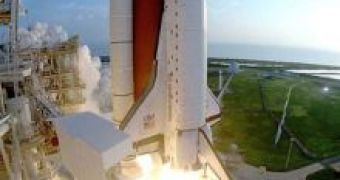At an evening press conference Tuesday at NASA's Kennedy Space Center in Florida, Space Shuttle Program Wayne Hale reported that the external tank's performance was greatly improved during the launch of Space Shuttle Discovery at 2:38 p.m. EDT.
"I have a good report," Hale said. "The tank performed very, very well indeed."
NASA placed more than 100 cameras around Discovery's launch pad for Tuesday's launch to detect any loose debris. The ISS will then take pictures of the vessel's heat shield while it performs a backflip during approach.
Based on early analysis of photographs taken during ascent, just a few items have been identified for further study. Some involve debris particles shed by the massive orange tank, which supplies liquid oxygen and liquid hydrogen to the orbiter's three main engines during the climb to orbit. The observed particles are small, and all occur after the time frame -- up to two minutes, 15 seconds into ascent -- that engineers consider to be the most aerodynamically sensitive time for the shuttle.
About fifteen minutes into the flight, astronauts on board Discovery filmed a large piece of ice tumbling away from the orbiter. The ice, which forms on the exterior of the main engines, has been observed on previous flights and is not considered an issue.
Moreover, up to six pieces of debris that could be foam insulation fell off Discovery's troublesome external fuel tank minutes after liftoff. Columbia's demise in February 2003 was caused by foam insulation that peeled off 70 seconds after liftoff and struck its heat shield.
"About two minutes and 47 seconds give or take (after the Discovery launch), we saw three perhaps four pieces come off (the fuel tank)," said Hale, adding that it was unclear whether it was foam or "something else." "We also saw another piece or two come off at about four minutes 50 seconds," he said.
"We don't see any concern for the orbiter," Hale reported, and added that in the coming days, the STS-121 crew will take a closer look at Discovery using the orbiter boom sensor system as well as the slow back flip that will allow further photography of the orbiter from the International Space Station.
Photo Credit: NASA

 14 DAY TRIAL //
14 DAY TRIAL //